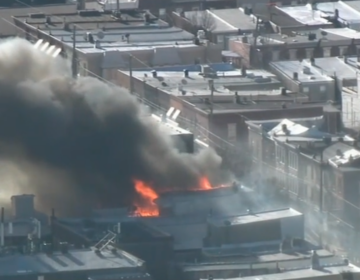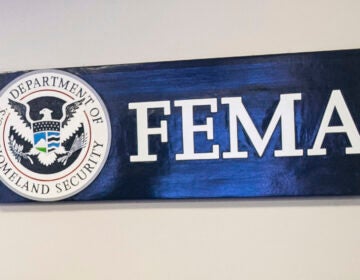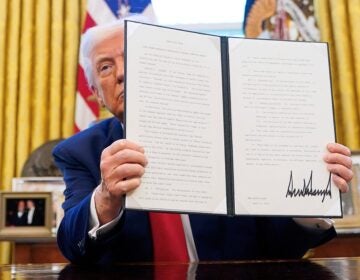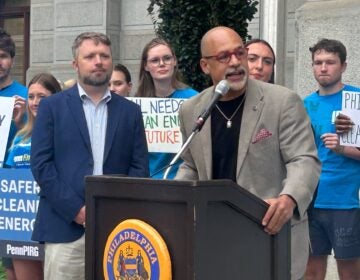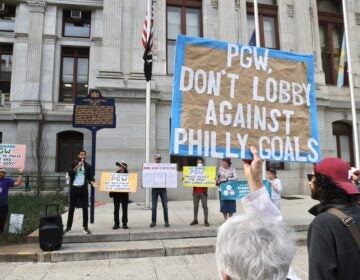Gas industry group that includes PGW lobbies against federal funding for Philadelphia and state
The American Public Gas Association wants Trump to limit funds for cutting carbon emissions. Philadelphia Gas Works is its largest member.
Listen 6:38
PGW works to contain a gas leak on Olney Ave. in Philadelphia on February 27, 2025. (Kimberly Paynter/WHYY)
This story is part of the WHYY News Climate Desk, bringing you news and solutions for our changing region.
From the Poconos to the Jersey Shore to the mouth of the Delaware Bay, what do you want to know about climate change? What would you like us to cover? Get in touch.
As Philadelphia and Pennsylvania officials work to preserve federal funding to fight climate change, a natural gas industry group whose largest member is Philadelphia Gas Works, has asked the Trump administration to do a “comprehensive review” of those same federal dollars.
The lobbying effort is occurring as the city and state work to maintain the $700 million in federal funding to reduce climate-warming emissions and promote clean energy.
The industry group is targeting programs that would decrease the use of natural gas to heat buildings by using electricity instead. The federal funds include heat pump subsidies, contractor training grants and appliance rebate programs, along with cutting carbon emissions of federal buildings through electrification.
Some of the federal funds would go directly to the city while others would go to nongovernmental organizations.
Climate advocates say the transition toward heating buildings with electricity would equal long term cost savings for customers.
PGW, the nation’s largest municipally owned gas utility with more than 500,000 customers and 1,600 employees, said it did not have knowledge of the lobbying effort. The city-owned utility is an active member of the American Public Gas Association, the umbrella organization for about 1,000 nonprofit gas utilities that remain publicly owned, and which the association’s website says “are directly accountable to the citizens they serve.”
PGW pays $58,000 in annual dues to the trade group, according to the utility’s fiscal year 2025 operating budget. The trade group recently listed PGW’s director of regulatory strategy as chair of its committee on government regulation.
Climate activists and ratepayer advocates have criticized the use of PGW customers’ dollars to fund lobbying, especially when it undermines climate policies and goals of the city.
“This means that they are forcing ratepayers to fund [American Public Gas Association’s] anti-climate lobbying against the City and ratepayer’s interests,” said Mitch Chanin, a volunteer with POWER Interfaith. “Instead of opposing federal support for innovative programs that reduce energy bills, clean our air, protect our climate, and create green jobs, PGW should prioritize the needs of Philadelphia’s communities.”
It wouldn’t be the first time PGW has come under scrutiny for lobbying. Previously, PGW has tried to head off any local legislative efforts to promote electrification.
That occurred in 2021, when PGW executives engaged in crafting, and potentially strengthening, a statewide measure proposed in Harrisburg that would have blocked efforts by the city to promote electrification, according to emails obtained then by WHYY News. The bill was not enacted but a newer version was introduced in March of this year.
In February, the American Public Gas Association joined five other industry groups to petition the new heads of the Department of Energy and the Environmental Protection Agency to review the federal funding approved by Congress, and “to highlight our concerns regarding building electrification programs that warrant your immediate attention.”
President Donald Trump made his intentions to shift away from former President Joe Biden’s climate agenda and toward expanding fossil fuel development clear from day one, promising to “drill baby drill” in his Jan. 20 inauguration speech.
Philadelphia, however, has made a commitment to reach net zero carbon emissions by 2050, in part through building electrification. Both the city of Philadelphia and the state are working to preserve all federal funding awarded during the Biden administration.
In 2024, Mayor Cherelle Parker announced a strategy to alleviate energy poverty, noting that a high number of Philadelphians spend a disproportionately large amount of their income to heat and cool their homes. Part of that strategy includes the use of electricity to heat and cool buildings.
Building electrification is a key component in reducing climate warming emissions. Installing heat pumps, for example, serves as an alternative to heating homes and businesses with natural gas, which requires drilling for methane, shipping the gas through a network of pipes and then burning the fossil fuel in basement boilers.
Leaks of the climate warming gas can occur at all stages of production and distribution, while burning the gas releases greenhouse gases and air pollutants, such as nitrous oxides and volatile organic compounds.
Like most cities, the bulk of Philadelphia’s climate emissions come from heating and cooling buildings. Philadelphia’s 2021 Climate Action Playbook says buildings account for about 72% of the city’s overall climate pollution.
City Council Minority Whip Nicolas O’Rourke, of the Working Families Party, said the APGA’s effort directly conflicts with Philadelphia’s climate and funding priorities.
“Building electrification, it’s not a small thing in the city of Philadelphia. It’s essential to our stated and legislative vision,” O’Rourke said. “There is definitely a contradiction between what the city is trying to do and what [the American Public Gas Association] is trying to do.”
Joe Goffman, a former top EPA official during the Biden administration, said the goal of electrification is to cut costs for consumers while also cutting pollution and improving public health.
“It sounds like they’ve taken every argument at their disposal, including the kitchen sink, and thrown it at this electrification policy,” Goffman said.
$700 million in funding at risk
The money in question comes from two federal laws passed during the Biden administration to tackle climate change and promote jobs.
The Infrastructure Investment and Jobs Act, also referred to as the Bipartisan Infrastructure Law, was passed by Congress and signed by then-President Biden in 2021. The measure allocated $75 billion for green energy projects and upgrades to the electrical grid.
The Inflation Reduction Act, which became law in 2022, includes $391 million in funding and tax incentives as the nation’s largest investment in efforts to cut climate polluting greenhouse gas emissions and promote clean energy. It pledged $70 million in grants to states, tribes, local governments and the private sector.
The city has said those two bipartisan measures have allocated $700 million to the city and state to address impacts from global warming.
That includes $19.8 million for the city to design and enforce building codes that would increase energy efficiency by methods like electrification.
Potentially at risk is $20 million for the Grays Ferry Community Resilience Hub, which in part will help improve energy efficiency and electrification for 189 homes in the South Philadelphia neighborhood through the city’s Built to Last program. The program, funded by the Inflation Reduction Act and allocated through the Community Change Grants program, would also provide training to 50 residents for jobs in heating, ventilation and air conditioning HVAC as well as energy audits.
“Federal support on that is critical for the city to meet its actual stated climate goals as we imagined them,” O’Rourke said. “[The letter is] directly counter to the city of Philadelphia’s sustainability goals.”
In addition, Pennsylvania manufacturers have already received $40.8 million in grants through both new laws to jump start electrification technologies such as heat pump production and for job training programs.
Philadelphia officials say the city and organizations were allocated more than $55 million for tree planting, climate justice programs and grants to “adopt the latest or zero energy building codes.”
Other funds, which could come in the form of financing and incentives, would help cut climate pollution and reduce emissions at the Port of Philadelphia.
While all this money was allocated before Trump took office, the president has been rescinding these funds or freezing them for further review.
Letter expresses ‘concerns regarding building electrification’
The trade group’s Feb. 21 letter illustrates the natural gas industry’s effort to bolster Trump’s agenda to expand fossil fuel production and withdraw funding for some programs that tackle climate change.
The two-page letter was addressed to Department of Energy Secretary Chris Wright and EPA Administrator Lee Zeldin.
It specified Wright’s focus on “affordability and consumer choice for home appliances” in his order to “Unleash Golden Era of American Energy Dominance” and Zeldin’s “Powering the Great American Comeback” initiative, which also focuses on “energy dominance” that “will cut energy costs for everyday Americans.”
In March, Zeldin announced rollbacks of dozens of air and water protections. In the letter, the trade group asks the Trump administration to go further.
“On behalf of America’s home heating oil and propane distributors, public utilities, plumbing and HVAC service professionals, and manufacturers of liquid- and gas-fired consumer appliances, our organizations write to express our strong support for your agencies’ renewed focus on energy security, reliability, and consumer choice,” the trade group wrote.
“In keeping with these priorities, we would like to highlight our concerns regarding building electrification programs that warrant your immediate attention.”
To that end, the APGA letter asks for a “comprehensive review of all building electrification programs under the [Inflation Reduction Act] and [Infrastructure Investment and Jobs Act],” including rebate programs, contractor training grants, heat pump subsidies and electrification of federal buildings.
It also seeks review of the “utilization of funds under the Building Energy Codes Program to support adoption and implementation of building codes that support mandated electrification.”
City Councilman O’Rourke said the “review” being sought is code for “eliminate.”
Requesting a comprehensive review “from this slash and burn administration has a particular intent to it that I think is hard not to overlook,” O’Rourke said. “I think it’s naive to read into this letter anything other than an effort to gut the work that has gone into getting us away from dirty energy towards clean energy.”
The argument the APGA makes to the Department of Energy and EPA against funding electrification programs focuses on “consumer choice” and increased costs for consumers.
“Our members have voluntarily improved environmental performance through cost-effective solutions such as adoption of renewable heating fuels, high efficiency appliances and equipment, contractor training, and consumer education,” the letter said. “Building electrification programs established by the Inflation Reduction Act (IRA) and Infrastructure Investment and Jobs Act (IIJA) ignore and even undermine these achievements, restrict consumer choice, and jeopardize American energy security and grid reliability.”
The letter from the trade group and other industry organizations also asks for a review of any related guidance to electrification and the use of the social cost of carbon in defining a zero emissions building. It also wants a review on protocols for conducting home energy audits for weatherization programs.
The letter concludes with a request for a meeting with Secretary Wright and Administrator Zeldin.
The letter does not object to programs in the funding stream that have flowed to gas utilities. This includes tax credits for replacing gas furnaces, for more efficient gas powered heaters and the billions of dollars slated to fund seven hydrogen hubs across the country, using $7 billion from the infrastructure law.
The APGA also wants the two federal agencies now under Trump’s control to review the following 2024 reports done during the Biden administration:
- “Decarbonizing the U.S. Economy by 2050: A National Blueprint for the Buildings Sector.”
- “Achieving a Net-Zero Federal Emissions Building Portfolio.”
- “National Definition of a Zero Emissions Building.”
A complex relationship
The trade group lobbies for its 730 utility members at the federal level. It did not respond to multiple requests to answer questions for this story.
Neither PGW CEO Seth Shapiro nor Philadelphia Mayor Cherelle Parker would agree to an interview about the letter. The utility and the city would only discuss the matters through emails.
The relationship between the mayor, the city and PGW is complex. The mayor appoints members of the nonprofit Philadelphia Facilities Management Corporation, which appoints the CEO of PGW. Shapiro was appointed as PGW’s CEO in December 2020, with the approval of then-Mayor Jim Kenney.
PGW’s executives oversee the utility’s day-to-day operations while the Philadelphia Gas Commission approves PGW’s budget. The mayor appoints two of five members on the commission.
PGW denies any role in trade group’s anti-electrification efforts
PGW spokesman Dan Gross said in an email that the utility did not know about the trade group’s efforts or the letter.
“No one at PGW was involved with the creation or distribution of this letter,” Gross wrote. “In fact, no one here had seen the letter until you brought it to our attention.”
Gross would not say whether PGW’s CEO Shapiro or the utility management agreed with the letter’s contents. The other signatories are the National Propane Gas Association, American Supply Association, Plumbing Heating Cooling Contractors Association, National Energy and Fuels Institute, and Oil and Energy Service Professionals.
PGW, which is the nation’s 10th largest gas utility overall and had $664 million in revenues last year, is by far the largest one represented by the trade group. As recently as last month, Michael Artuso, PGW’s director of regulatory strategy, was listed on the AGPA website as chair of the trade group’s regulatory committee.
When asked about Artuso’s post, PGW’s Gross said the listing was “incorrect,” but would not elaborate or say whether Artuso has ever played a leadership role with the trade group. Attempts to reach Artuso for comment were unsuccessful.
But on March 25, the same day WHYY News inquired about Artuso’s role with the trade group, Gross said Artuso’s name had been removed from the website at PGW’s direction.
Gross would not answer questions about whether or not PGW had applied for or was planning to apply for any of the programs funded through the two initiatives. One opportunity for PGW to take advantage of these federal dollars in question is through the Rise PA program, which includes $396 million funded for industrial sites statewide to cut their carbon emissions through a number of ways including electrification.
Mayor Parker’s spokesperson Joe Grace stressed in an email that the city “was not involved in any way in the trade group” or the letter.
‘We’re really talking about stakes for human beings’
In February, Pennsylvania Gov. Josh Shapiro — no relation to PGW chief executive Seth Shapiro — sued the federal government, seeking to claw back over $2.1 billion in frozen federal funding, including funds appropriated through the infrastructure and inflation reduction measures.
After the lawsuit was filed, the Trump administration unfroze the funds, but some of the funding promised to flow to city agencies and organizations has either been terminated, blocked or is under review.
Former EPA official Goffman said the trade group’s argument ignores the cost-cutting aspects of electrification, as well as the savings associated with improved public health.
“I wouldn’t dispute the number of the investments that the utility is making and the claims they’re making about what they’re trying to achieve,” Goffman said. “But if they really want to continue on a trajectory of saving money and cleaning up from a pollution and climate perspective, supporting these grants is an essential next step.”
Burning natural gas not only emits climate warming gases, but also air pollutants like nitrogen oxides, particulate matter, carbon monoxide and volatile organic compounds. Cutting climate emissions has the added benefit of cleaner air.
“A lot of people live in communities where there’s very strong evidence of illness, avoidable early death and significant medical conditions that are directly linked to the pollution they’re exposed to,” Goffman said.
“We’re really talking about stakes for human beings, not just dollars and cents, but even if all you cared about was dollars and cents, it’s economically self-defeating to expose people to health threats that can otherwise be avoided.”

Get daily updates from WHYY News!
WHYY is your source for fact-based, in-depth journalism and information. As a nonprofit organization, we rely on financial support from readers like you. Please give today.



